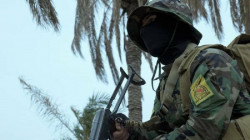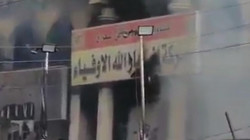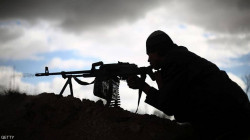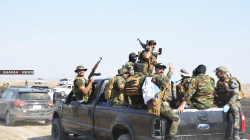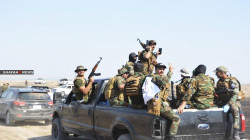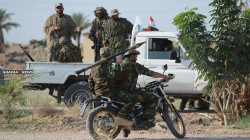Symbioses of power in Iraq and the Popular Mobilisation Units

Shafaq News / In 2014, after the fall of Mosul, Grand Ayatollah Ali al-Sistani issued a fatwa calling for Iraqi citizens to join the security forces to fight ISIS. This ushered the PMU into existence as over 60,000 fighters volunteered, creating militias with differing command structures, and variations of coercive, financial, political and socio-religious power. It also bolstered the ranks of the existing Shi’ite militias, including those backed by Iran.
However, today, this wave of unified cooperation motivated by the expedient need to defeat ISIS has long since deteriorated. As a consequence, the core narrative by which the PMU portrays itself as a cross-confessional force, fighting on behalf of the entire Iraqi nation against the evil of ISIS, is waning. Instead, many of the groups have now become self-empowering and self-enriching political forces.
Badr Organisation
One such force is the Badr Organisation. Founded in 1982, the fervently Shia group staunchly opposed Saddam Hussein. It is derived from the former military wing of the Islamic Supreme Council of Iraq, whose fighters lived and trained in Iran.
They returned after Saddam was overthrown, to carve out their share of the war economy through gaining political power and expanding informal and illicit economic activity. Their leader, Hadi al-Ameri, is a political heavy weight, despite being a controversial figure through his role in the large-scale murder of Sunni civilians during Iraq’s 2005–2006 sectarian conflict.
For many years, he held the Interior Ministry, enabling Badr to control the Hashd Commission, elements of the Iraqi federal police and sections of the Iraqi army. In the most recent elections in 2018, the Badr Organisation, Kata’ib Hezbollah and Asa’ib Ahl al-Haq formed the Fatah Alliance. They came second in the 2018 general election, with cabinet positions such as the transport ministry. They have thrived in a system immersed in a culture of ‘elite bargaining’ and competition over power, benefits and financial gain.
Kata’ib Hezbollah
Kata’ib differs from Badr, its ally, because it is significantly less institutionalised, preferring to stay out of reach of the state, and, therefore, freer from accountability. The group is linked to the Iranian Revolutionary Guard Corps’ external arm, the Quds Force. Like Badr, it promotes the idea of the velayat-e faqih, recognising the Supreme Leader of Iran as the guardian of the Ummah.
Instead of working in the corridors of power, it positions itself as a military “resistance” force with hardened battlefield experience and astute regional strategies. It has the overarching mission of fulfilling Iran’s regional strategy against the US, Israel and Saudi Arabia. The prioritisation of this objective, which requires the raising of funds, alienates them from the local population and the wider Sunni Arab community.
This can be seen in their conversion of 1,600 farms into a military zone in the southern side of Qa’im, depriving the local farmers of work. In addition to this, they hold sectarian sentiments, which, combined with their ill-discipline and greed, has seen Sunni locals exploited and discriminated against.
Asa’ib Ahl al-Haq
Asa’ib is also known for its fighting prowess, and, like Kata’ib, its reputation has been defiled by atrocities against Sunnis. However, despite abuses against locals and predatory economic activity, they have strong ties with the Jabour Sunni tribe in Salahuddin, owing to their more political aspirations. The tribe has its own mobilised forces under the PMU and has worked extensively with Asa’ib.
Its leader, Qais al-Khazali, is one of the most influential men in Iraq. His political party, the Sadiqoun Movement, competes against the Sadrists in elections. Asa’ib split from the Sadrist Mahdi Army after Sadr became critical of Iranian influence over Iraq.
Saraya al-Salam
The authentically Iraqi Saraya al- Salam, under Muqtada al-Sadr, previously the Mahdi Army, differs greatly from the aforementioned Shia Islamists groups. The traditional rival to the Badr Organisation, Sadrists are becoming increasingly more critical of Iran.
Remembering the Mahdi Army’s role in the sectarian cleansing during 2005-2006, they should be approached with caution, however, today, Sadr’s forces show more discipline and less sectarian discrimination.
Instead, Saraya al-Salam has strong political representation, encouraged by its charitable welfare system and its ability to mobilise constituents. The strong sense of legacy left by previous Sadr family members also helps to sustain legitimate support. Its political wing, the Sairoon Alliance, won 54 seats in the 2018 election.
Failing to form a government, however, the party was unable to orchestrate their planned reforms against corruption and the sectarian system and instead joined with the Fatah Alliance.
Abbas Combat Division
Like the Sadrists, the Abbas Combat Division has socio-religious legitimacy, but little financial, political and coercive power. Along with the Ali Akbar Brigades, they were formed to protect the shrines, Najaf and Karbala, and are loyal to Sistani.
Due to their cross-sectarian appeal and popular charitable works, proportions of Sunni Arabs have joined these Shia-led PMU groups.
Common trends
Groups affiliated with Sistani and Sadr are working towards strengthening the state and counterbalancing the Iran-backed groups. Further assimilation of them into the Iraqi Security Forces would highly benefit the security situation and could set the trend amongst other groups of becoming more institutionalised.
The state’s interactions with sub-state actors and differing authorities like Sistani and Sadr arguably gives it more credibility in reforming and shaping a peaceful Iraq, making use of its nuanced symbioses of power.
Nevertheless, groups such as the Badr Organisation, that have been competing and negotiating over conflict resolutions and post-war positions for years, have imposed their dominance in this system of transactional politics. A system whereby coercive and economic power offer greater rewards than socio-religious legitimacy.
Source: Global Risk Insights
